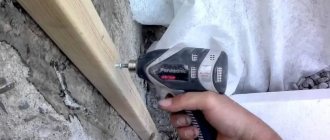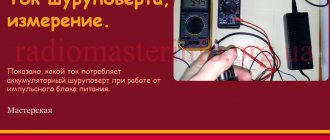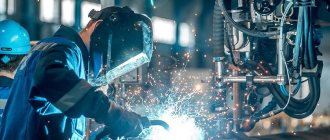Any concrete mixer (including a mixer based on a Kamaz vehicle) is designed to optimize, facilitate and speed up the work process on a construction site. Sometimes it makes more sense to order a Kamaz with a ready-made solution. In some cases, you can prepare the concrete by hand. But even if the volumes of solution you need are small, and you have enough strength to mix the mixture in a trough with a shovel, our good advice is to buy a concrete mixer or rent one. The design of a concrete mixer depends on the expected load, continuous operation time and the amount of solution.
Rating of concrete mixers
Manufacturers offer concrete mixers equipped with electric motors. This technique is used in the construction of dachas and country houses, commercial real estate and industrial enterprises. Each facility has its own requirements for the equipment used, so concrete mixers are varied. Our experts selected models from well-known brands to compile a rating and assessed compliance with the stated parameters, performance, and reliability. The opinions of users and reviews of professional builders were taken into account.
The main attention was paid to the following features and characteristics:
- Operating principle – they produce forced-action concrete mixers and gravity models;
- Engine power – affects performance;
- Drum volume – determines how much mixture can be prepared in one batch;
- Material – manufacturers use steel, cast iron, impact-resistant plastic;
- The thickness of the drum walls affects durability and resistance to shock loads;
- Power supply – operating from 220 and 380V mains;
- Tipping - a steering wheel or lever is provided for unloading;
- Dimensions – equipment with low productivity should be convenient for transportation and storage.
Not all equipment could pass expert testing. Poor stability, engine power not matching the declared data, weak levers and drive gears - concrete mixers with such defects were excluded from our rating.
The best vibrating plates
Causes of malfunctions
Before you start repairing a concrete mixer, you need to determine what exactly is broken in it. Among the most common problems are:
- The concrete mixer does not start (it turns off after starting). Such a nuisance can happen for several reasons: the start button is faulty; the power cable is damaged; the most dangerous is that the electric motor burns out.
- Loud motor noise and no drum rotation. Most likely, the cause of such a breakdown is in the unit that transmits rotation; the belt may have stretched or it may fly off because the pulley teeth are dirty. The breakdown is quite common and can occur due to too frequent overloads.
- The device hums, but the drum does not spin. Most likely the capacitor, which is located in the wall of the electric drive, under its box, has failed. After replacing it with a similar one, the problem should be eliminated.
- Engine overheating. A very common problem with electric stirrers. It can be triggered by the following negative factors: overload; impacts, falls or sudden shocks of the device; improper storage; during operation, the air temperature did not correspond to that required for the concrete mixer (indicated in the passport); the winding or its insulation is damaged; the bearing has collapsed.
- Rotate the drum in the opposite direction. Most likely there was an electrical failure.
The best concrete mixers up to 120 liters
When independently building a summer house, a house, or when performing repair work on a small site, a large drum volume is not required. The lifespan of the solution is limited, so a model for 80-120 liters is sufficient. Concrete mixers for home are small in size; the equipment can be brought into the room through a standard doorway. At the same time, the technology has good performance.
Bison Master BS-120-600
Designed for the preparation of solutions of small and large-sized fractions. Gravity type with a spacious drum in which you can prepare up to 60 liters of solution. The mixing blades have a special shape, and a powerful 600 W asynchronous motor rotates the “pear” at a speed of 27 rpm. This allows the mixture to be prepared within 2-5 minutes. The crown is made of durable, corrosion-resistant cast iron.
The drum body is made using pressing technology from sheet steel 2 mm thick and can withstand high static and dynamic loads. The drum is protected from corrosion by a polymer powder coating based on a polyester composition that is resistant to atmospheric influences. An electromagnetic switch with protection against accidental start-up is installed. The drum can be fixed at any angle.
Advantages:
- The engine does not require maintenance;
- Easy unloading;
- The blades are bolted;
- Fits in the trunk of a car;
- Extended warranty 5 years;
- A set of fasteners is included.
Flaws:
- Not detected.
Unlike most models, the articulation of the large gear and the drive shaft here is carried out not using a flat, but through a key. This protects the gear from turning under high loads and eliminates the possibility of grinding. As a result, service life is increased and operating costs are reduced.
Profmash B-140
The body is made of carbon steel sheet, 2 mm thick. The container is resistant to mechanical shock. Polyester-based powder paint provides good corrosion protection. The crown is made of glass fiber reinforced polyamide. The material is resistant to abrasion and has an increased service life. The polyamide crown is easy to replace, and in operation it has a minimal noise level.
The gear is connected to the drive shaft by welding. This reduces the risk of spinning under maximum load. The blades are bolted to the body, which reduces vibration. The steering wheel type tilting mechanism can be fixed in one of seven positions.
Advantages:
- Wheels on a wide axle;
- Large steering wheel diameter;
- Leg lock;
- Power supply from household power supply;
- Reliable electric motor.
Flaws:
- Short cable.
Kraton BeeTone 70
Compact electric concrete mixer for 220 volts, gravity type. Equipped with an economical asynchronous electric motor that drives a 65-liter capacity. In one batch you can prepare 46 liters. solution. The rotation speed reaches 27 rpm, which allows you to complete mixing within 3-6 minutes. The container is made of sheet metal with anti-corrosion coating.
The electric motor is reliably protected from dust, moisture, and mechanical impact by a housing made of impact-resistant plastic. Electrical wiring is double braided. Tilting the drum using a lever with a comfortable textured handle. The frame has wheels for moving around the construction site. The crown is made of durable cast iron alloy.
Advantages:
- Small sizes;
- Replaceable gear;
- Low noise level;
- Uniform mixing.
Flaws:
- The operating speed is noticeably reduced when fully loaded.
Altrad
This brand is produced by a Polish manufacturer. As for their disadvantages, mention should be made of the inconvenient mechanism for tilting the drum, which often fails. The existing toothed belt drive can cause engine failure, but this is only if the drum jams. Among the advantages are thick blades that are almost impossible to bend. In terms of maintenance, bearing replacement is very difficult.
How to choose a concrete mixer
The question of which concrete mixer to choose for individual construction or for a professional team cannot be called rhetorical. Failure of this equipment will cause a slowdown in the pace of construction and the need to mix concrete manually. To prevent bloody calluses from appearing on your hands, it is recommended to choose a reliable concrete mixer. It is worth understanding the operating principle of the model you like, paying attention to the power characteristics, drum volumes and finished mixture. An important role is played by the material from which the crown, container, and equipment frame are made.
Preparation for repair
Typically, repairing a concrete mixer comes down to replacing a failed part. The first thing you have to do is determine which part was damaged, and then purchase exactly the same new one somewhere. The concrete mixer is repaired by the owner himself, without seeking help from specialists, since this does not require any special skills or tools.
Every owner can easily find everything needed for repairs on his farm.
The list of tools that you cannot do without when repairing a concrete mixer includes:
- spanners;
- hammer (or in special cases a sledgehammer);
- pliers (they are used to remove and install retaining rings);
- screwdrivers;
- multimeter;
- tweezers.
However, this list is only conditional, since much in the repair of concrete mixers depends on the nature of the breakdown.
Operating principle
They produce gravity and forced concrete mixers. The equipment is equipped with electric motors, but the mixing principle differs. In gravity models, the tank rotates, the blades mounted inside capture the solution, lift it up, after which, under the influence of gravity, the concrete falls and is picked up again by the blades. High intensity cycles ensure uniform mixing. The advantage is the need for a low power motor.
The forced-type device consists of a fixed container in which a central drive axis with blades is installed. The equipment operates on the principle of a classic mixer. The advantage is that the tank volume is not limited. Disadvantage: it requires a powerful electric motor that consumes a large amount of energy. For example, a 250-liter gravity installation consumes 800-1000 W, a forced installation consumes 5500-6000 W.
Power
Affects productivity, the ability to prepare a large volume of cement mortar in one batch. The ability to work as long as possible without stopping depends on power. When choosing, it is necessary to take into account the characteristics of the electrical network to which you plan to connect the equipment. For a holiday village, it is recommended to buy a model with a 700-1000 W electric motor. The operation of this equipment will not cause an emergency in the power supply system.
Advantages and disadvantages
Advantages:
- The manual mortar mixer is completely autonomous.
- A motor-driven concrete mixer also has a high degree of autonomy and only requires fuel.
- The crown is quite simple to repair and operate.
Flaws:
- The disadvantages of concrete mixers include their seasonality. Most, especially small concrete mixers, are unsuitable for use during periods of sub-zero temperatures . This makes it necessary to adapt a steam generator to work with them in winter.
- There are more expensive concrete mixers that can work in any season, which initially have a steam generator unit built into them.
- A conventional mortar mixer, designed to operate only at positive temperatures (at least 2°C), is not equipped with devices that provide heating of the mixture.
- The disadvantages of a manual mortar mixer are low productivity and high labor intensity of mixing.
- The disadvantages of motor-driven concrete mixers are: high cost of fuel, toxicity of exhaust gases and high noise level when the engine is running.
- The disadvantage of electric concrete mixers is that when the power is turned off, after a certain period of time, the hatch opens and the mixture is discharged to prevent it from hardening. In addition, ring gears require frequent removal and cleaning or repair of the ring, while gearboxes require replacement of the entire gearbox if they break down.
Drum volume
One of the main technical indicators. Must match the intensity of the construction team. A single master will produce 25-35 liters of masonry mixture in an hour (lifetime of the solution). For these purposes, you can purchase an inexpensive concrete mixer with a tank of up to 100 liters. A small team, consisting of a master and two apprentices, consumes 2-2.5 times more material. To effectively organize work, you will need a 150 liter model. A full-fledged professional team of builders will provide the solution to a technician with a 250-300 liter drum.
Material
The crown is made of polymer materials or gray cast iron. Polyamide is lightweight, durable, reduces noise levels. A crown made of this material is easy to repair or replace. Cast iron has a low price, but increases the weight of the equipment. Components made from this alloy cannot be repaired. Polyamide models always top the rating of concrete mixers for the home, as they are easier to maintain and do not cause discomfort to neighbors in the area.
Drum wall thickness
The “pear” is made of sheet steel – a strong, durable material. During operation, the walls experience impact and abrasive loads. The thicker the wall, the better the equipment copes with mixing coarse-grained solution. For seamless drums, sheet steel 1.5-2 mm is recommended. It should be taken into account that when pressing in places with a complex configuration, the material stretches and becomes thinner. For welded structures, 3-4 mm steel is recommended.
Using a concrete mixer
When buying or renting a concrete mixer, you need to consider the following factors:
Drum capacity volume
- for private construction, a mortar mixer with a volume of 100 to 300 liters is sufficient;
- Professional construction requires devices with working capacities of more than 300 liters.
Other criteria:
- Power . For private construction, a power of 700-800 W is sufficient.
- Voltage . Non-professional models operate at a voltage of 220 V.
- Class . There is no professional level required for custom construction . Such equipment is much cheaper.
- Seasonality . If there is no urgent need to build in winter, then a conventional unit is sufficient to operate at positive temperatures. It is cheaper and at positive temperatures high quality concrete .
- Strength of working capacity . You should choose containers made on rollers. They have a worse appearance than elongated ones, but are made of thicker steel, are strong and durable.
- Overload sensor . It is desirable to have a device for automatically shutting off the concrete mixer when the temperature in the motor winding rises excessively.
- Material . The most reliable are units with a cast iron crown.
- Loading-unloading . The presence of such a system ensures convenience and efficiency in the preparation of the mixture.
When working with a concrete mixer, you must follow the standard procedure:
- it is necessary to check the serviceability of the unit externally;
- then a test run is performed with an empty working container (either drum or shaft);
- the unit is stopped and prepared for operational start-up;
- the working container is filled with water, cement, sand, filler and additives;
- After complete mixing, the unit is emptied of the solution by draining through the hatch or turning the drum over.
Which concrete mixer is better?
The cost of equipment of the same class can vary by 2-4 times. For this reason, the question of which concrete mixer is better is not idle for builders. It is necessary to choose a technique taking into account the scope of application and intensity. It is recommended to understand which model is suitable for fine-grained plasters, and which one is suitable for preparing concrete for a monolithic foundation. The VyborExperta.ru team recommends the following participants from our TOP 10, taking into account the purpose of the equipment:
- Bison Master - for intensive work on a personal plot;
- Kraton BeeTone 70 – for the construction of a small cottage;
- Whirlwind BM-200 - will help out during the construction of a low-rise building during normal work;
- Eco CM-192 – will take its rightful place on the cottage construction site, where people work intensively;
- Stroymash SBR-260V-01 - equipment for the construction of a mansion, 2-3 floors high.
All the concrete mixers presented in our review will fulfill the assigned tasks, but only models with convenient unloading and thermal engine protection are worthy of the title of the best mixers in their class.
Concrete laying
- Once mixed, the concrete must be transported to site in a manner that prevents segregation and maintains homogeneity of the mixture.
- The concrete in the mixer must be transported to the job site. There it is poured into a mold of suitable material according to the design requirement.
- Laying concrete is a very important operation, which largely determines the strength of the structure and its durability.
- Any method of transportation must protect the concrete from exposure to weather conditions.
Preparation of concrete mixture
After the device has been assembled, the owner has familiarized himself in detail with how to use it and checked the unit for functionality, it is necessary to prepare the mixture in a certain proportion.
For example:
- To prepare one cubic meter of concrete, 125 liters of water are required. Do not allow excess liquid. This may lead to a decrease in the strength of the solution.
- Sand with a grain size of up to 5 mm is required. Its amount should be 30-45% by weight of the finished solution.
- Gravel takes up 55-70%.
- The ratio of sand and gravel is 1:1.2. When using crushed stone instead of gravel, the ratio should be: 1:2.
Approximate ratio of materials in a concrete mixture
High-quality concrete can only be obtained using clean sand and water, without contamination with oils or any aggressive substances. In summer the water is used cold, and in winter it is heated to 40°C. The concrete mixer is ready for operation - what it looks like before turning it on is shown in the photo.
Preparing the unit for switching on
To better imagine how to use a concrete mixer, the video lesson will tell you in detail. After finishing the work, the question is how to clean the concrete mixer?
Wherein:
- The internal and external surfaces of the unit are washed.
- The drum is washed with crushed stone and water.
- Solvents must not be used.
- Do not allow water to come into contact with the engine.
- The tightness of all fasteners should be checked periodically.
- The engine ventilation openings should always be kept clean.
The video in this article shows in detail how to properly assemble a concrete mixer or disassemble it after use.
Actuator
The most common type of drive is an electric motor. However, there are also concrete mixers with a gasoline engine, as well as with a manual drive, when the worker himself acts as the engine and rotates a special handle.
So, in most cases, a regular concrete mixer with an electric motor is purchased. It is, as a rule, asynchronous, which means that it will wear out for a very, very long time, since there is no friction inside it, like commutator motors with carbon brushes. The power of the engine directly depends on the volume of the drum - the larger it is, the more powerful the engine is needed. Typically, concrete mixers with a total drum volume of 120-140 liters are equipped with units of 500-600 W, and more spacious ones - with 800-1000.
Electric motors can be 380 or 220 V. 380 V is mainly used on large concrete mixers. On devices with a total drum volume of up to 250 liters, 220 V is usually used.
But there are situations when there is no power supply near the construction site. And there is no way to bring a generator either. In this case, you will have to buy a concrete mixer with a gasoline engine or with a manual drive.
Gasoline-powered machines should not be considered as an alternative to electric concrete mixers in places where there is an electrical network, as it requires too much attention. This includes constant topping up of gasoline, as well as periodic oil changes. And in general he is more capricious. Therefore, buy such a mixer only when working away from electrical outlets.
Concrete mixer with gasoline engine
Manually driven concrete mixers allow you to save both on the purchase of the apparatus itself and on the electricity consumed. But it is advisable to buy such a unit only if the volume of work is small. At a more or less large volume, the employee will simply be exhausted. Yes, and you won’t be able to mix too much per unit of time in this way, so in general the work will go much slower, even if you don’t feel sorry for yourself or the person who will work with the concrete mixer.
Manual concrete mixer
Mechanical mixers
A homemade mechanical concrete mixer with your own hands is very similar in appearance to a gravitational one. The main difference is inside her.
These are guide and cutting blades welded to the inner walls of the container. They direct the fall of the overturned layers, cutting them into separate parts.
In this case, the dough will be of higher quality and in a shorter time. The presence of blades changes the very principle of gravitational mixing. Therefore, the working container can be positioned not only horizontally, but also at an angle, which allows for more efficient use of the volume of the concrete mixer and makes work more convenient.
In addition, a working container installed at an angle to the horizontal no longer requires a sealed lid, and the finished mixture can be dumped through a constantly open hole by turning the working container itself over.
Making a working container
You can also use a steel barrel as a working container, to the inner walls of which steel blades should be welded at an angle of 30-35 degrees. The height of the blades should be equal to a quarter of the diameter of the barrel. It is possible to weld the blades to a rotating shaft running inside.
A more difficult option would be to make a container of your own design, a kind of homemade product. To do this, you will need a piece of thin-walled steel pipe with a wall thickness of 2.5-3.5 mm, a diameter of at least 800 mm and a length of at least a meter.
The supporting frame is best made from steel profile pipes.
One side of the pipe is welded with a steel circle. On the other side, 4-6 triangular segments are cut out, which are folded to the middle and welded together. The result is a container resembling a pear. The blades are welded inside the pear, and in the center, on the outer side of the bottom, a steel axle is welded for subsequent fastening of the drive pulley.
They are less susceptible to bending than angle bars and are relatively lightweight. The frame design should include the installation of support wheels on which the container will rest, and a platform for installing the electric motor.
The frame itself should consist of two parts:
- the support on which the entire structure will be supported;
- rotating, on which the working container will rest.
Support frame with handle and wheels.
The supporting and rotating parts of the frame are connected to each other through short shafts mounted in bearings or bushings.
A transverse handle must be welded to one of the shafts to allow tilting of the rotating part of the frame, and with it the working container, which will lie on the frame, resting on wheels.
Mechanical concrete mixer drive
The drive for rotating the mixer in devices of this type is extremely rare and only with a small volume of working capacity. Typically, an electric motor connected to the mixer through a belt drive is used for rotation.
It is even better to connect the electric drive through a gearbox, but a self-made concrete mixer in this case will be too expensive in terms of the necessary components. In factory designs, you can see a gear drive from a motor installed on the side of the tank, at the location of the largest diameter, but with self-manufacturing, such a solution is only theoretically feasible.
Development of mechanisms: subtleties
Gravity system
The best purchased option for such a concrete mixer would be a 180 liter Bruder or Zitrek; the Skiper CM-120 brand is no less popular, although this is a more expensive option. Or you can save money completely by making a gravity-type concrete mixer yourself from scrap materials, using a drawing of the device. This type differs from other options by the mixing method, which is carried out using gravity. A mandatory point is the presence of fixed blades inside the drum. The difference is that the drum is located on an axis so that the pear can tip over freely, which simplifies the moment before transferring the solution to a tractor or construction trolley.
A gravity concrete mixer allows you to prepare cement mortar from fillers of different fractions. There are both manual, forced type, and electric.
Mechanical concrete mixer
The construction of small structures or the usual pouring of the foundation does not require large concrete mixers; developers often make do with homemade mechanisms that differ in the principle of impact, namely:
- Forced mechanical method. Often combined with gravity. The principle of the device is a horizontal or inclined pear with a built-in mixer inside. There are also mixerless concrete mixers, in which case the fixed blades are responsible for the quality of the mix. Purchased analogues - Limex 190 LS, Lebedyan.
- Forced vibration. While mixing concrete, the container remains motionless. The role of the mixer is carried out by the mixer, which produces compression waves. An electric drive is used, the power of which must be no less than 1.5 kW.
- Combined gravitational-mechanical. Involves combining two methods.
A little about the rules of operation
- When working, the concrete mixer must stand steadily, preferably on a flat surface.
- Components should only be loaded into a rotating drum.
- The kneading lasts approximately 2-3 minutes. After this, the rotation should be stopped and unloaded from the non-rotating drum. Otherwise, the support bearing may quickly wear out.
- After work, you should rinse the concrete mixer with water so that the frozen solution does not cause you trouble during the next work.
These are the features of choosing and operating a concrete mixer. Happy shopping and happy work!
Video “How to choose a concrete mixer.”
Manufacturers
There are European manufacturers, there are Russian ones, and there are our brands that order concrete mixers from China.
The first two options will be more reliable. Of these, we will highlight the Eastern European companies Limex and Zitrek, and from the Russian concrete mixers from the cities of Lebedyan (Lipetsk region) and Beloretsk (Bashkiria). The first ones are produced either under the name Lebedyan or Denzel. The latter are best known under the brands Profmash, Entuziast, and Teplotrade. But they are also produced under other less well-known names - the main thing is that they are assembled in Beloretsk.
Chinese concrete mixers are available, for example, under the brands Prorab, Elitech, Wert, Kraton and many others. Not to say that they work poorly, but, firstly, their build quality is poor (the holes may simply not match during assembly), and secondly, if they break down, it can be difficult to find spare parts.










